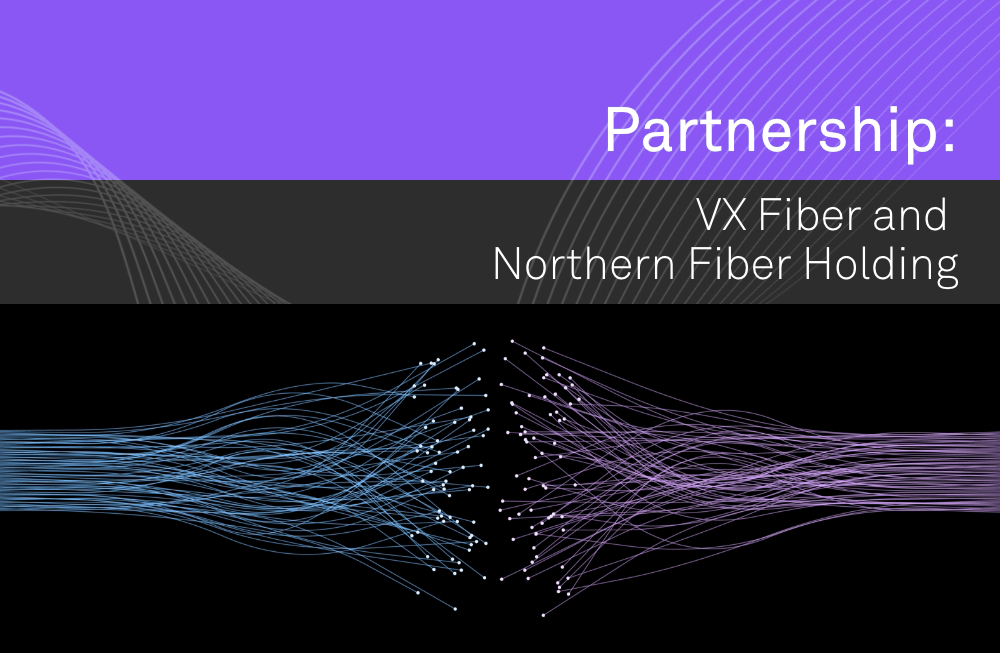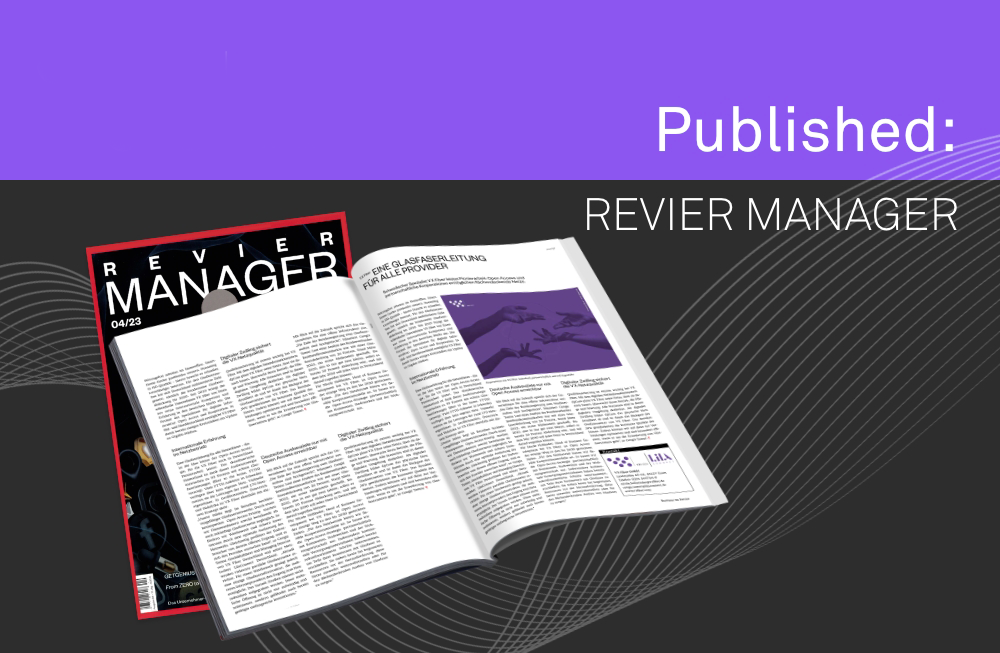In a new ISPreview.co.uk interview the Chairman of Swedish operator VX Fiber, Mikael Sandberg, has helped to illuminate the “stark difference in attitude towards fibre in the UK compared with Sweden” and highlights some of the ways in which FTTP broadband deployments on this side of the channel could be improved.
At present VX Fiber (inc. subsidiary LilaConnect) is deploying a new gigabit-capable Fibre-to-the-Premises (FTTP) broadband network across several areas of the UK, including in the Staffordshire city of Stoke-on-Trent (100,000 premises – here), the town of Colchester in Essex (8,000 premises – here), parts of London (3,000 premises via Prime Fibre) and the towns of Crewe and Nantwich in Cheshire (here). Bristol is expected to follow soon.
NOTE: VX Fiber, which is headquartered in Sweden, has operations in South Africa, Costa Rica, Malaysia, the UK, Belgium, Austria and Germany.
However, VX Fiber itself hails from Sweden, which is one of Europe’s most well-developed markets for full fibre network coverage. The country started building fibre optic networks way back in the late 1990s, and in 2009 it set out a strategy for ensuring that 90% of premises could access 100Mbps+ speeds by 2020; the bulk of which would be FTTP. At around the same time the UK was just starting to focus on a hybrid fibre (FTTC / HFC) dominated rollout.
Some 81% of Sweden now has access to a full fibre network (here), which compares with around 24% in the UK today (here), and over 60% of homes in Sweden have connected to the service. But despite the slow start the UK has, over the past three years, started to build FTTP at a much more rapid pace – thanks to various policy / regulatory changes, tax breaks and investment schemes.
Suffice to say that we were keen to understand more about what VX Fiber’s Chairman, Mikael Sandberg, had to say about the differences in fibre strategy between both countries.
A Little Context
Mikael himself has a long history of working with FTTP networks, having done two Master’s degrees on them in the late 1980s/early 1990s and later becoming the MD of broadband ISP Bostream in 2001 (this was sold to Bredbandsbolaget in 2004), before helping to found and lead the Quadracom Group in 2005.
In 2014, Quadracom was sold to TeliaSonera (the Swedish/Finnish incumbent), and as part of that deal Mikael was not allowed to engage in any competitive ventures in Sweden for a period of three years, so he worked with a team to set-up VX Fiber (then known as VenturaNext) and focused on other markets instead, such as the UK.
VX Fiber’s core business is being an open access fibre operator and nowadays also a fibre builder and investor. As a fibre builder and investor, VX Fiber works in partnership with other fibre owners to deploy large scale fibre networks, which it then operates. As a fibre operator, VX Fiber will invest hardware and software, monitor and control the network and engage third party Service Providers.
NOTE: VXF’s subsidiary, LilaConnect, is the one responsible for marketing, selling, installing and maintaining the connections from this new infrastructure to residents and businesses. Lila supplies access via a number of ISPs, such as Air Broadband, Breeze Fibre and Pure Broadband etc.
Opinions on UK Fibre Policy
According to Mikael, there is a “stark difference in attitude towards fibre in the UK compared with Sweden” and “it came as no great surprise” to him, as well as the rest of the UK industry, when the Government finally watered down its gigabit-coverage target from 100% to a minimum of 85% by the end of 2025. “It had always been seen as a political ambition,” added Mikael.
In Sweden the rollout of full fibre infrastructure was driven early on by local authorities that recognised its economic and social benefits, as well as with some state aid support from a pro-fibre central Government. The country also grew through the wide adoption of an open access model, where one operator builds the network that many ISPs can harness (the UK is more a mix of closed and open networks, with Openreach being the biggest open access provider).
Despite this, Mikael sees the UK’s new £5bn Project Gigabit programme as being “proof” of the Government’s commitment to deliver, although he warns that “the main barrier to getting Britain connected is funding” and “what is on offer … merely scratches the surface of what it needed to get to 85%, let alone 100%” coverage.
In fairness, we disagree with the remark about existing funding not being enough to get to 85%, since under the current plans it does look as if “gigabit-capable broadband” services via commercial investment will be able to reach around 80% of UK premises by the end of 2025.
Openreach’s FTTP build alone is planned to hit 81% by Dec 2026, while Virgin Media’s network will have separately reached 55-60% by the end of 2021. Add in all of those full fibre altnets (like VX Fiber) and, even accounting for overbuild between rivals, 85% suddenly seems like a viable prospect. But pushing that to 100% will be a much bigger challenge, which may explain why the UK hasn’t set a solid completion target for it.
Elsewhere, Mikael would like to see more operators sharing access to the infrastructure they build in order to tackle overbuild (easier said than done), greater flexibility on service bundles (i.e. giving consumers more freedom to take some services from different providers) and for ISPs to adopt a labelling scheme (example) on their broadband packages in order to help show the benefits of a gigabit or full fibre plan.
The full interview gives this all more context and also touches on many other areas, such as the way in which UK consumers “don’t yet get the distinction between fibre and service” and what the Building Digital UK team need to do in order to improve the Project Gigabit programme. You can read it all below.
The Interview
1. You’re currently building a number of Fibre-to-the-Premises (FTTP) style broadband networks in several UK locations, such as Stoke-on-Trent, Colchester and parts of London. Can you offer us a progress update on each of those projects (e.g. premises passed, areas where you’re now deploying and expected completion etc.)?
Mikael’s Answer:
Stoke-on-Trent: The project spans across two distinct areas:
Stoke-on-Trent City Council appointed VX Fiber as their partner to deliver the DCMS funded LFFN using the Open Access Operator Model, a model which ensures the best economic and social returns on that investment. The city network (Stoke-on-Trent Private Optical Network) is owned by Stoke-on-Trent City Council, whilst VX Fiber has been contracted to build and operate the infrastructure in the public domain. The City Council recently announced (7 June 2021) its Silicon Stoke Prospectus which set out the city’s digital ambitions. Whilst VX Fiber is working closely with the City Council to help realise many of their long-term ambitions, there was a significant milestone announced in the Prospectus in relation to the completion of their 113km city network which underpins the delivery of the desired outcomes and benefits.
Via our fibre-deployment business LilaConnect, we are further investing in the build of the necessary access infrastructure to connect over 100,000 premises across Stoke-on-Trent. LilaConnect hit a major milestone at the beginning of June, passing half a million metres of completed civils work over the last year, over 35,000 premises passed so far.
Colchester: In March this year (2021), VX Fiber kick-started the build of a full fibre open access network across Colchester. The project is part of Colchester Borough Council’s wider plan to transform and future-proof the town’s digital infrastructure and establish itself as one of the best provisioned towns in the country, providing full fibre broadband to homes and businesses across the city. VX Fiber is making a multi-million pound investment into the necessary access infrastructure to connect premises. Via our fibre-deployment business LilaConnect, work is progressing well to enable an initial 8,000 homes and businesses within Colchester to benefit from direct access to full fibre gigabit broadband connectivity.
London Grosvenor: Our partnership between Grosvenor, VX Fiber and our Service Provider partners, under the project name “Prime Fibre”, will create a transformative full fibre open access network across Mayfair and Belgravia, which forms part of Grosvenor’s digital strategy, where over the next few years, Grosvenor will invest in one of the largest “single estate” upgrades in broadband. To date we have passed over 3,000 premises, with plans in place to extend beyond the existing catchment areas.
2. What were some of the biggest challenges that VX Fiber encountered in the aforementioned builds and how did you resolve them?
Mikael’s Answer:
3. By now VX Fiber and LilaConnect should have a built-up (no pun intended) a fair bit of experience in deploying a gigabit speed Fibre-to-the-Premises (FTTP) network within the United Kingdom.
How would you say the market for such services differs here from VXF’s home turf of Sweden, and is there anything that you think we could learn from the Swedish approach to such infrastructure?
Mikael’s Answer:
There is a stark difference in attitude towards fibre in the UK compared with Sweden. In the early days’ fibre rollout in Sweden was often driven by local authorities and district councils, as they recognise both its economic value and social benefits. As a result, Sweden has nearly 80% FTTP, with over 60% connected. The main difference today is the subscribers’ understanding of the value of the fibre itself. The UK is almost unique in Europe in that consumers don’t yet get the distinction between fibre and service.
We share the view with several large sophisticated investors in this sector that in the future every business and household will have [at least] one fibre and all services will be over-the-top (“OTT”) with mobile services being the main access method for about 10% of the market and otherwise complement the fixed [fibre] connection.
Part of the success of fibre coverage in Sweden is down to the wide adoption of the open access model. In this model the physical fibre is not necessarily owned by the same company who provides the service, but by different types of fibre owners, such as local authorities, private investors, utilities, real estate, and landowners. Through a Fibre Operator, they lease the fibre to multiple Service Providers to enable them to access and use the network to deliver their own broadband services. This lowers costs for the Service Providers, encourages greater competition and leads to much higher uptake and financial returns for the fibre owners. However, it does not lead to price erosion as many [UK] ISPs fear.
In addition, we cannot forget that wider societal technology adoption is a central part of Sweden’s DNA. Again, this has been driven by a commitment from, and funding by, the Swedish Government. For example, in the 1990s the Swedish government offered a tax break for residents to buy personal computers. And in 1994 Stockholm built the world’s largest open fibre network – with 100% of businesses and 90% of homes tapping into that infrastructure today. The Stokab fibre network (in Stockholm) has delivered an estimated £1.8bn return on investment and it has been said that it has saved the local government over £250m in IT and Telecoms services alone.
This combination of intrinsic knowledge together with key lessons learnt have been the driving force behind our pioneering Open Access Model and partnership approach in the UK. And it has worked – both have been right at the very heart of discussions with UK stakeholders looking for alternative options in getting their communities connected. VX Fiber’s partnerships with Stoke-on-Trent City Council, Grosvenor Britain & Ireland, and Colchester Borough Council, amongst others, signify the growing recognition of VX Fiber’s unique collaborative – and software-defined Open Access approach to fibre connectivity in the UK.
VX Fiber’s integrated hardware and software can be quickly deployed on new and existing fibre networks offering genuine open access to all types of subscribers, promoting choice in the market and a strategic revenue-generating asset for fibre owners.
4. Back in September 2020 it was announced that global investment firm AMP Capital had acquired a majority stake in the company. VX Fiber has also previously said they would be “targeting an advanced pipeline of opportunities in the UK.”
Are you now able to reveal anything more about your future plans or deployment locations for the UK, beyond those that have already been announced?
Mikael’s Answer:
There’s a healthy appetite in the market for AltNet providers who have an innovative approach to the FTTP market. We cannot go into the details of future plans, but we are in a healthy position to progress our ambitious plans for expansion which also includes owning the physical fibre infrastructure. To reiterate what was communicated during the announcement in September, “… as well as its existing projects in Sweden, South Africa and the UK, VX Fiber is also in the process of “targeting an advanced pipeline of opportunities in the UK, Belgium, Austria and Germany.”
VX Fiber will continue with its successful fibre operator strategy partnering with owners of passive fibre infrastructure and inviting Service Providers of all types and sizes to sell their services over a rapidly expanding universe of consumer and business subscribers.
VX Fiber will also continue as fibre owner and investor, deploying full fibre access networks to complement other fibre networks. As a fibre owner, VX Fiber will not compete with other fibre owners (our traditional clients) but complement their ambitions.
We have a wide project portfolio in terms of networks we are either planning or in full operation. Pressing new projects in the UK include the deployment of FTTP networks in Crewe & Nantwich and Bristol that commences over the next couple of months, as well as a significant expansion in London. In Austria, Belgium and Germany, we are in the final stages of planning to build in new regions across these countries.
5. The Government has now revealed the strategy for their £5bn UK Gigabit Broadband programme, which has adopted a mix of vouchers, gap funded deployments and some continuation of the Local Full Fibre Networks (LFFN) model (i.e. dark fibre for public sector sites). But it also softened the initial coverage target to a “minimum” of 85% (UK premises) by the end of 2025 and only released £1.2bn to support that.
After that there’s talk of more investment being released to help the scheme “get as close as possible to 100%” coverage, but only if the “industry can demonstrate it has the capacity to deliver further and faster.”
In terms of pros and cons, what are your thoughts on the new gigabit programme as it exists today?
Mikael’s Answer:
It came as no great surprise to the digital infrastructure industry, when the target to connect 100% of UK homes and businesses was reduced to 85% – it had always been seen as a political ambition.
The UK Gigabit Broadband programme (including the various funding and investment options); and other announcements that have been made during past Spending Reviews, Budget Statements, election manifestos and Queen’s Speeches – are proof of the UK Government’s commitment to getting the UK connected. Despite this, one of the main barriers to the deployment of a UK-wide FTTP network is funding – particularly in rural areas. What is on offer from the UK government merely scratches the surface of what it needed to get to 85%, let alone 100%.
First, it would be remiss of us to forget – or not acknowledge – that over the past 18 months the country’s fiscal position has substantially worsened. The pandemic has placed an enormous and unexpected burden on the UK economy. However, the resulting financial strain must not be allowed to derail the UK’s infrastructure spending ambitions – it will be internet connectivity that helps the UK with future economic growth and ‘building back better’.
Secondly, let’s be clear that the Government’s policy for ‘gigabit-broadband infrastructure’ has always been that it will be mostly built by private investment. And at a time when public purses have been stretched by unprecedented COVID-19 support measures, the industry cannot, and should not, rely solely on public funding.
The private sector now has an even more important role to play in helping to bridge the gap needed to deliver the Government’s ‘Connected Britain’ vision. In this context, private funding and/or investment is one of the solutions available to fibering up, faster. In fact, private sector investment should be a major driver of the UK’s ‘infrastructure revolution’.
Here lies the problem – it’s not always been made that easy for private investors to play their part. The government, together with OFCOM, made a commitment to make policy reforms to promote a competitive market for the roll-out of gigabit- capable infrastructure. But a lack of clarity surrounding the availability of private investment opportunities within infrastructure projects still exists.
A vital part of any ‘UK Gigabit Broadband Programme’ needs to address how the UK Government plans to reinvigorate the infrastructure ‘investment’ market to support its ambitious infrastructure agenda, and provide better connectivity, at good value for taxpayers. Part of this is for the Government to commit to an approach that gives confidence to investors and capitalises on the attributes of businesses and the public sector. One way of doing this is to open-up – and communicate the availability of – individual regional or local digital infrastructure projects to multiple external investors. Not only does this present a huge and scalable opportunity it could open-up a more sustainable territory for private investors. This will help the UK establish itself once again as a world class destination for investment.
6. Two of the biggest challenges faced by all operators during 2020, and into the first half of 2021, has been the global COVID-19 pandemic and Brexit (e.g. the January 2021 trade agreement). Combined, these two issues have placed complex pressures on everything from the workforce (there was already an issue with a lack of skilled fibre engineers) to supply chains. What problems did these cause your own company and how did you adapt?
Mikael’s Answer:
For VX Fiber, collaboration has always been at the heart of our operations. Working closely with key stakeholders during the global pandemic has been crucial to see us safely through these difficult times. Our goal hasn’t faltered, a gigabit-connected Britain remains well and truly in our sight.
When it came to the challenges we faced as a workforce, these were predominantly concerned with day-to-day working practices. During the first lockdown in 2020, the telecoms industry was added to the list of the critical sectors vital to the Government’s response to the pandemic. It also made the decision to actively encourage local authorities not to introduce blanket refusals of permits or notices for street works. In pre-COVID times, the process to get the greenlight to undertake street works to install fibre could take up to 3 months.
Along with others in the industry, VX Fiber worked closely with the Government to ensure strict adherence to guidelines and directives – ensuring that the health and safety of contractors, staff, customers and the general public were the number one priority for the business. The key-worker status – given by the government, meant that the industry was able to forge ahead with the roll-out of new full fibre networks, but with modifications that considered all tasks through a protection-orientated lens.
Any works involving network maintenance and fault repairs, customer repairs, network build and increasing network capacity were able to continue as normal. Although most new installations in customer premises were put on hold during the critical lockdown period, these are starting to be reinstated against stringent operating procedures. The industry was, and still is, committed to ensuring that targets are not side-lined by the coronavirus crisis, so it has been prepped and ready to get customers connected in the safest possible way.
The pandemic is continuing to hamper some parts of the full fibre connectivity supply chain, but the government’s response enabled network construction to accelerate. Those involved in the rollout of full fibre adapted to the working environment to ensure there was no significant delay to gigabit speed rollout across the UK.
7. This year saw Ofcom publish the outcome of their first combined Wholesale Fixed Telecoms Market Review 2021-26 (FTMR), which proposed major changes to help boost investment in “full fibre” broadband and high-capacity Ethernet services for residential and business connectivity markets. What do you think they got right, and what do you think they got wrong (if anything)?
Mikael’s Answer:
The emphasis on wholesale I think is absolutely right. However, as mentioned earlier, the main barrier to getting Britain connected is funding. Private investment – in addition to public funding – is needed if the UK government is going to hit the 85% target. However, it’s not always been made that easy for private investors to play their part. The Government, together with OFCOM, made a commitment to make policy reforms to promote a competitive market for the roll-out of gigabit- capable infrastructure. But a lack of clarity surrounding the availability of private investment opportunities within infrastructure projects still exists. This needs to be addressed, and this needs to happen fast.
8. Earlier this year Ofcom also proposed a new “one touch” migration (switching) system for UK broadband ISPs (here), which from December 2022 will make it easier for consumers to switch between ISPs on physically separate networks (i.e. extending the existing Gaining Provider Led [GPL] solution to include alternative networks, rather than just Openreach).
Broadly speaking this new system, while adding new challenges for smaller providers, will still represent an important change that should help alternative networks to attract customers away from the biggest players. But are there any areas where you think Ofcom could have improved their proposed approach?
Mikael’s Answer:
Consumers often run into trouble if they wish to swap from a bundled package (e.g. broadband and phone) to, for example, a standalone broadband deal because your old ISP could end up charging you more for the line rental to remain with them if they cannot also serve you broadband. Subscribers on service bundles are not being offered clarity when they only want to buy a part of what is being offered. I believe in a future when consumers are free to choose the best service from the best suppliers and can easily combine these in a way that suits them (not the supplier). Such regulation has already been implemented in Germany for example and I think this is an area that needs to be addressed with urgency in the UK.
9. Over the next four years we will increasingly see the market move away from traditional phone lines (PSTN) and adopt a more IP (e.g. VoIP) based future, which requires ISPs to be prepared with alternatives (something full fibre providers already need to consider).
What kind of solutions do you offer for this and how will you tackle situations where a home covered by your network may only require a home phone service (i.e. no broadband), possibly as part of a migration away from traditional (non-IP) phone provider?
Mikael’s Answer:
This is clearly an important issue, especially for vulnerable subscribers. Our independent Service Provider partners are well-equipped to provide the necessary IP alternatives and increasingly subscribers are turning to mobile solutions for their voice services.
10. At the time of writing there are around 70-80 alternative network providers that are building gigabit-capable fibre networks for consumers (summary). The market is becoming increasingly crowded for altnets and history suggests that a rise in consolidation will almost inevitably follow at some point. What are your views on the potential for future consolidation in the market, and do you see your own network as being ripe for purchase by a rival further down the road?
Mikael’s Answer:
It’s encouraging, and we are proud, to see so many altnet providers including VX Fiber become such a driving force in helping the UK to achieve its ubiquitous internet connectivity goals. Interestingly, to build and to own passive fibre infrastructure does not benefit much from economies of scale and therefore many small [passive] fibre networks can survive well. When it comes to operating such networks, or indeed selling services, there are however, very large economies of scale. As a fibre operator partner VX Fiber can bring such scale to a small [passive] fibre network and thus we would benefit from a fragmented [passive] fibre market. Based on these economic fundamentals, in most markets we observe consolidation in the service sector first where economies of scale are the greatest.
11. One other significant risk from the emergence of so many altnets is that it will probably fuel a greater degree of consumer confusion, thus making the market much harder for the ordinary individual to understand (i.e. lots of different networks, with different availability and different ISP choices etc.). What do you think should be done to help communicate and simplify the market for consumers?
Mikael’s Answer:
I strongly believe in the need to reignite the debate around fibre confusion. Your review in December 2020 “WIK Study Finds Consumers Still Confused by Fibre Advertising” highlighted the need for the UK to introduce much stronger guidelines and/or legislation to help dispel this confusion. The clearest and most user-friendly approach could be the introduction of a labelling scheme similar to the traffic lights introduced in Italy, whereby technologies with differing characteristics would be colour-coded. The approach taken in France where only ISPs delivering fibre into the home or premises are permitted to use the term ‘fibre’ in advertising material is another model that has merit in its simplicity.
12. Commercial competition between full fibre providers in urban areas has become increasingly aggressive. Indeed, over the past few months we’ve started to see more examples where three providers have all built networks in the same area (overbuild).
The Government’s 2018 Future Telecoms Infrastructure Review (here) made clear that “at least a third (with the potential to be substantially higher) of UK premises are likely to be able to support three or more competing gigabit-capable networks.”
On the one hand this gives consumers extra choice and a better chance of getting a good deal. On the other hand, locals suffer more disruption from multiple builds, while overbuild does little to improve overall UK coverage and can also make it harder for providers to attract investment by stretching the payback period or risk. What is your position on all this?
Mikael’s Answer:
I am a strong proponent of creating a competitive environment which enables customers to enjoy exceptional services and freedom of choice at competitive prices. However, as you say, aside from the fact that overbuild does little to improve overall UK coverage, why put local residents through the disruption of multiple builds. It would make sense not to overbuild existing networks and avoid deploying a second or even third fibre network to areas where an open access full fibre network already exists. Instead, why not lease capacity from existing network operators? Why not work with other network providers, instead of overbuilding them, at least until we have full coverage across the UK?
13. Speaking of competition and overbuild. Last year the Independent Networks Co-operative Association (INCA) proposed the creation of a Common Wholesale Platform (CWP), through which alternative networks could provide wholesale services to third-party providers and ISPs.
INCA believes that a CWP would enable groups of independent wholesale network providers to “combine together and offer a real competitive alternative to the limited number of large players which currently dominate the market.” What are your thoughts on the pros and cons of this idea?
Mikael’s Answer:
Fundamentally, offering a large as possible universe to Service Providers through one interface would make the altnet sector more competitive. It is however really important to understand that it is not just a question about a technical interface. Service Providers should be offered standard commercial and operational interfaces as well. VX Fiber has such interfaces, which have been honed over our 20-years of operating history and we are keen to help unify the altnets for the benefit of Service Providers. VX Fiber is, and always will be, a ‘true’ Open Access operator – giving customers a choice and the ability to select the services that match their specific needs from a wide-range of Service Providers.
As the average UK consumer does not yet see the difference between the fibre and the service, UK residential and SME business customers can buy both a fibre connection and service, as a single proposition from LilaConnect.co.uk (VX Fiber’s sister company and fibre-deployment business) until we begin to get a level of “fibre maturity” seen in other European countries. But as a neutral wholesaler, VX Fiber is committed to building and operating open-access full-fibre networks, information on – and business profiles for – a host of additional Service Providers’ is available on the LilaConnect website. Customers can contact the Service Providers directly if they choose to buy their services.
We’d just like to take a moment to thank Mikael Sandberg for providing such detailed and constructive responses to our interview questions. We look forward to seeing how VXF and Lila progress over the coming years.






